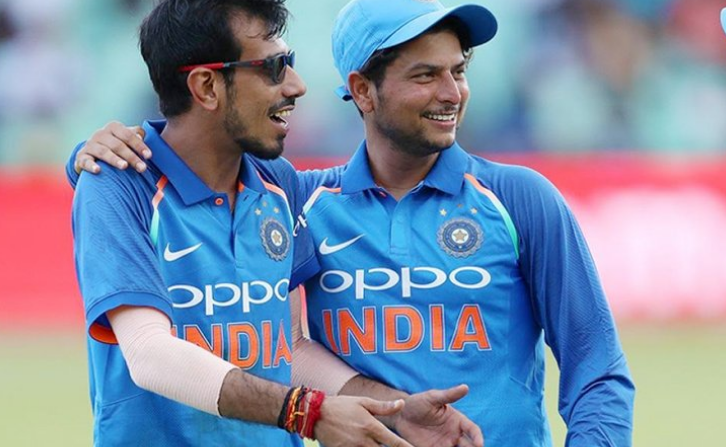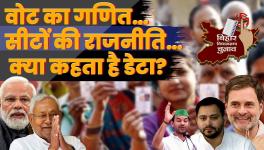On The Ball | Wicket-Taker vs Economy Bowler: Indian Cricket Team’s Call Defines Its Philosophy

Induction of Kuldeep Yadav and Yuzvendra Chahal into the Indian cricket team ODI set-up is a clear indication as to which side the Virat Kohli-Ravi Shastri leadership is inclined towards (Pic: BCCI).
One of the more interesting elements of the telecast of Indian Premier League matches is the audience poll. Earlier this week, viewers were asked what they thought was the more decisive factor in 20-over cricket – economy, or strike-rate.
The outcome took me by surprise. A staggering 75% of those who participated in the process plumped for economy, just a quarter of all respondents voted for penetration.
In our formative years, it was drilled into us by our coaches that the best dot-ball was the one that had ‘W’ attached to it. That the attitude must always be to start off looking for wickets, and then revisit the approach depending on the conditions, the nature of the surface, the quality of the opposition, the state of the match. That 4 for 55 from 10 overs in a 50-over game was infinitely more telling than 0 for 32. But in the changing milieu of cricket, who is to say that attack (with the ball) is always the more prudent option.
Read More | Bajrang Punia’s Millennial Dilemma: India’s Olympic Favourite Shows Chinks in Defensive Armour
There is no easy – and definitely no correct – answer to the economy versus strike-rate debate. There can’t be; in the dynamic world of T20 cricket specifically, and limited-overs cricket in general, the goal posts keep shifting, necessitating attitudes and game plans to be modified accordingly. With the boundaries being brought in and bats having evolved to the extent that the sweet spot is now a giant area without adding pounds to the weight of the willow, even mishits sail way into stands. Discretion is the better part of valour even if one is the most attacking, most aggressive, most skilled deliverer of the cricket ball.
As tremendously annoying as it is to hear bowler after bowler turn up at press conferences and hold forth on ‘hitting the right areas, stacking up dot-balls and building pressure on the batsmen’, it must be emphasised that they are primarily parroting the plans formulated in the change-room by the coaching staff, with no little assistance from the computer analyst.
A Shikhar Dhawan or a Prithvi Shaw, for instance, like to impose themselves on the bowling from the word go. Against such ferociously attack-minded batsmen, it might not be the worst option to strangle them through disciplined lines and lengths, thus appealing to their ego as much as their natural instincts. Denied the length or the width that might allow themselves to get off to a flyer, batsmen of their ilk often try to manufacture strokes, and pay the ultimate price. That’s a victory for astute boardroom planning, and the willingness and adaptability of the bowler in going against his grain.
But how effective, say, will this strategy be when you have only 110 runs on the board in a T20 encounter, or 160 in a 50-over match. Without the pressure of a burgeoning required rate, even the most flamboyant batsman will find it within himself to drop down a gear or two and play to the situation. Sitting back on the basics of discipline will prove counterproductive from a bowling perspective in such instances, so the only option available is to try and blast batsmen out if the surface is inclined to help the quicker men, or spun them to their doom is there is any assistance for the spinners. If it is a flat track, then a prayer won’t hurt, either.
Read More | On The Ball | Living in the Age of Shahid Afridi
One of the more pleasant fallouts of the Twenty20 revolution has been the increasing influence of spinners as a whole, and wrist-spinners in particular, on the larger scheme of things. Early predictions centred around the slam-bang format sounding the death-knell of the slower bowlers who, it was believed, would merely serve up juicy offerings that would fly off the bat and threaten the spectators deep in the stands.
Fortunately for the sport, those fears have been largely unfounded. Cricket’s most popular brand has, if anything, heightened the relevance of quality wrist-spin, undoubtedly the most difficult craft to master. The margin for error is minimal because the slightest indiscretion plays right into the batsman’s hands. But through hours of practice, and with empathetic captains willing to overlook the odd horror offering in the quest for game-changing wickets through the middle stages, wrist-spinners have established themselves as the most potent weapon in modern-day cricket.
The induction of Kuldeep Yadav and Yuzvendra Chahal into India’s One-Day International ecosystem towards the middle of 2017 was the clearest indication of which slant the Virat Kohli-Ravi Shastri leadership combine was inclined towards. R Ashwin had had a storied career in the 50-over format, with 150 wickets from 111 matches at an average of 32.91, an economy of 4.91 and a wicket every 40.1 deliveries. That all his matches had come between June 2010 and June 2017, when the average ODI scores flirted with the 300s, put his numbers in perspective. But in his last 10 bowls in ODIs, Ashwin only picked up 10 wickets, including three in what could be his final appearance for the country in that version. He still went at only 5.30 to the over in that last clutch of matches but only took a wicket every 56.4 balls; the think-tank perceived a pattern, perceiving that batsmen were able to score reasonably freely against the off-spinner despite not taking undue risks.
Read More | Caster Semenya vs IAAF: Protecting A Majority By Targeting the Minority
With an eye on the World Cup, they left out Ashwin and Ravindra Jadeja (who made a triumphant comeback last September after 14 months in the wilderness), opting to gamble instead with Kuldeep and Chahal. Kuldeep has since taken 87 wickets from 44 ODIs at an economy of 4.93 and a strike-rate of 26.4; the corresponding numbers for Chahal are 72 scalps from 41 matches, 4.89 and 30.1 respectively. Case rested, Kohli and Shastri might say.
While there is no template that favours incisiveness over frugality and penetration ahead of parsimony come what may, there are very few bowlers with impressive strike-rates and extremely high economy. The most miserly bowlers may not necessarily have wickets by the bushels to show for their control, but almost without fail, the prolific wicket-takers don’t go for runs aplenty on a consistent basis. That would indicate the superiority of the ability to take wickets over the propensity to staunch the flow of runs. But when you are left defending 11 runs in the last over of the World Cup final with five wickets standing, as Dennis Hopper asks Keanu Reaves in Speed, ‘What do you do, Jack?, What do you do?’
(Kaushik is a veteran cricket writer who has reported on over 100 Tests. He co-authored VVS Laxman's autobiography '281 and Beyond')
Get the latest reports & analysis with people's perspective on Protests, movements & deep analytical videos, discussions of the current affairs in your Telegram app. Subscribe to NewsClick's Telegram channel & get Real-Time updates on stories, as they get published on our website.
























